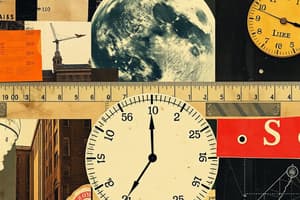Podcast
Questions and Answers
- .
- . (correct)
- .
- .
______ .
______ .
(SI) :
(SI) :
=
A b A=ab A SI
A b A=ab A SI
A b c
A b c
_____ .
_____ .
_____ _____ .
_____ _____ .
Cm / cm /
Cm / cm /
325 1/75
325 1/75
5 ______ .
5 ______ .
Flashcards
فیزیک چیست؟
فیزیک چیست؟
مطالعهٔ موجودات زنده و غیرزنده
علم
علم
گردآوری و سازماندهی معلومات
فناوری
فناوری
به کار بردن دانش برای اهداف عملی
اندازه گیری
اندازه گیری
Signup and view all the flashcards
کمیتهای اصلی
کمیتهای اصلی
Signup and view all the flashcards
کمیتهای فرعی
کمیتهای فرعی
Signup and view all the flashcards
کمیت های نرده ای
کمیت های نرده ای
Signup and view all the flashcards
کمیت های برداری
کمیت های برداری
Signup and view all the flashcards
متر (m)
متر (m)
Signup and view all the flashcards
کیلوگرم (kg)
کیلوگرم (kg)
Signup and view all the flashcards
ثانیه (s)
ثانیه (s)
Signup and view all the flashcards
دکا (da)
دکا (da)
Signup and view all the flashcards
دسی (d)
دسی (d)
Signup and view all the flashcards
نمادگذاری علمی
نمادگذاری علمی
Signup and view all the flashcards
تبدیل زنجیره ای
تبدیل زنجیره ای
Signup and view all the flashcards
دقت و درستی
دقت و درستی
Signup and view all the flashcards
دقت اندازه گیری
دقت اندازه گیری
Signup and view all the flashcards
اعداد بامعنی
اعداد بامعنی
Signup and view all the flashcards
تخمین مرتبه بزرگی
تخمین مرتبه بزرگی
Signup and view all the flashcards
کولیس
کولیس
Signup and view all the flashcards
ریزسنج
ریزسنج
Signup and view all the flashcards
چگالی چیست؟
چگالی چیست؟
Signup and view all the flashcards
آلیاژ
آلیاژ
Signup and view all the flashcards
Study Notes
- The OCR text is notes about physics and measurements.
- The notes include sections about the nature of physics as a science, measurement, units, and related subjects.
Physics: The Basic Science
- Physics encompasses the study of both living and non-living things
- Biology includes zoology and botany
- Physics is fundamental, covering the basic aspects of nature like motion, forces, energy, matter, heat, sound, and light
- Chemistry studies atoms and their combinations into molecules
- Biology relies on chemistry, which in turn relies on physics, establishing physics as the most fundamental science
Science and Technology
- Science gathers and organizes information, while technology applies this knowledge for practical purposes and provides tools for further exploration
- Technology can be both beneficial and harmful e.g. extraction and burning of fossil fuels for energy
- Assigning blame for problems like pollution to technology is unreasonable, it's how humans use it that matters
Importance of Measurement
- Measurement is essential for scientific understanding
- Kelvin emphasized that quantifying something is key to understanding it
Physical Quantities
- Physical quantities are used to study physical phenomena quantitatively
- Fundamental quantities can be measured directly e.g. time, length, and mass
- Derived quantities are measured indirectly, using relationships between quantities e.g. speed
Scalar and Vector Quantities
- Scalar quantities are fully defined by a number and a unit e.g. mass, time, and volume
- Vector quantities require both a magnitude and a direction for complete specification e.g. displacement, velocity, acceleration, and force
International System of Units (SI)
- The SI system provides a standard for measurements, ensuring global consistency
- It is also known as the modern metric system
- SI units facilitate communication and trade
- It defines specific quantities as base units and derives others from them
SI Base Units
- Length - meter (m)
- Mass - kilogram (kg)
- Time - second (s)
- Electric Current - Ampere (A)
- Temperature - Kelvin (K)
- Amount of Substance - mole (mol)
- Luminous Intensity - candela (cd)
Standards of Length, Mass and Time
- Meter is defined as the distance light travels in a specific fraction of a second
- Kilogram is the SI unit of mass, based on a platinum-iridium cylinder
- Second is the SI unit of time
Applying Measurement
- Use appropriate units according to the length
- For large distances use kilometers, for small e.g. millimeters
- Converting between units is a common task
- Older units include ' ذرع' and ' فرسنگ'
Errors and Precision in Measurement
- Measurements always have inherent errors
- Using precise instruments and methods can minimize error, but not eliminate it
- Precision is limited by the instrument's scale division
- Digital instruments has error equal to one unit of the last digit
Significant Figures
- Record numbers with appropriate level of significance
- Include a best guess in the report
- In multiplication and division the number of significant figures is equal to number of significant figures in least precisely known value
Scientific Notation
- An easy way to represent very large numbers
- Easily move decimal to where you want and multiply the remaining digits by an exponent
- Example
- 300000 can be written as 3x10^5
Changing Units
- Converting a unit into the unit we desire
- This can be done using using chain conversion
- Example
- 1/min equals 60 seconds
- 5min can be expressed with this conversion 5min=300sec
Other notes
- One liter equals one cubic decimeter
- Newton's second law equation F=am helps in figuring out relationships between quantities
Density
- Density is mass per unit volume, denoted by ρ
- Formula for density: ρ = m/V
- Units for Density is kg/m3
Studying That Suits You
Use AI to generate personalized quizzes and flashcards to suit your learning preferences.




